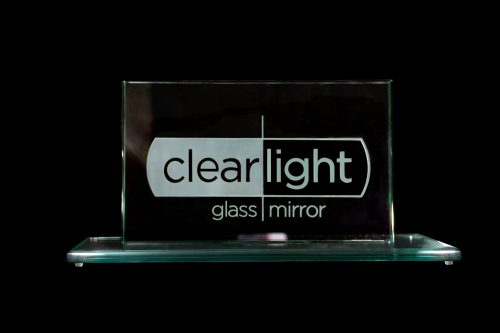The process for etching glass involves using a chemical or abrasive substance to remove a layer of the glass, creating a frosted or textured surface. There are a few different methods for etching glass, and the most common include:
- Sandblasting: This method involves using abrasive particles, such as sand or glass beads, to etch the glass. The glass is cleaned and then coated with a stencil or mask, which protects certain areas of the glass from the abrasive particles. The abrasive particles are then directed at the exposed areas of the glass, and they remove a layer of the glass and create a frosted or textured surface. This process allows for words or patterns to be precisely etched into the glass. The method of sandblasting also allows for the artistry of the etching to shine through.
- Chemical Etching: This method involves using a chemical solution, such as hydrofluoric acid, to etch the glass. The glass is cleaned and then coated with a stencil or mask, which protects certain areas of the glass from the acid. The acid is then applied to the exposed areas of the glass, and it reacts with the surface to remove a layer of the glass and create a frosted or textured surface. This is a common practice used for drinking glasses, or home use as it may require very little investment in machinery.
- Laser Etching: This method involves using a laser beam to etch the glass. The glass is cleaned and then coated with a stencil or mask, which protects certain areas of the glass from the laser beam. The laser beam is directed at the exposed areas of the glass, and it removes a layer of the glass and creates a frosted or textured surface.

Clearlight Glass and Mirror employs a high-tech sandblasting procedure to produce beautifully and uniformly etched images on flat glass pieces, including windows, mirrors, awards and most any flat glass surface. We have an MHG Glasmaster machine that is programmable for patterns, depth of etch and uniformity across large architectural glass. We then seal the etch to resist dirt, fingerprints and other debris from the etched areas.
Our special vinyl cutter and LXi software can accept almost any vector file and create custom designs, logos, fonts and patterns.
How do you clean and protect etched glass?
The best way to keep etched glass free of potentially damaging dirt is to clean it regularly with a glass specific cleaner. All glass looks best if kept clean and this is especially important for etched glass to help avoid staining its surface and causing permanent damage.
Allow us to etch your glass exactly as you wish it to be!
